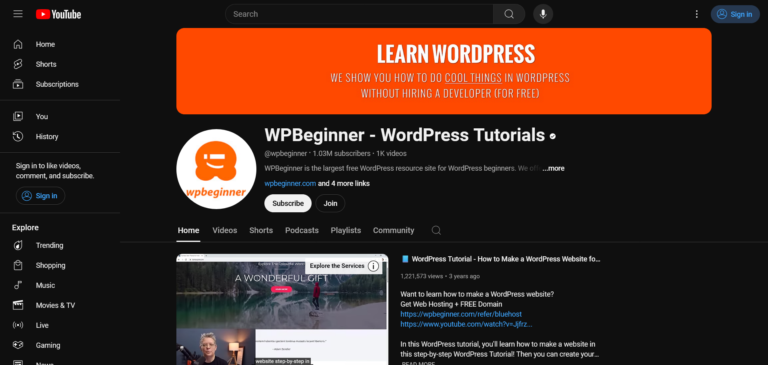Step-by-Step Guide to Starting a WordPress Blog: Get Online Fast
Key Take-aways
- Hosting Setup: Choose reliable hosting to establish your online foundation.
- Domain and WordPress Installation: Secure a domain name and set up WordPress to get started.
- Theme Selection and Customization: Customize your site with a theme that matches your brand.
- Essential Plugins and First Post: Add functionality with plugins and create your first blog post.
Are you ready to finally launch that blog you’ve been dreaming about? You’re in the right place. Starting a blog can be an exhilarating journey, and with the right guidance, you’ll be up and running in no time. In this guide, I’ll take you through every step, from choosing the best hosting provider to writing your first blog post. Follow these steps, and soon you’ll have a professional blog that captures your voice and vision.
1. Setting Up Hosting: The Foundation of Your Blog
Think of hosting as the plot of land on which your blog will be built. Just like constructing a house, you need a strong foundation. The hosting provider you choose stores all your files, ensuring your site is accessible and runs smoothly. Bluehost is an excellent option, especially for beginners, as it offers reliable customer support and a free domain for WPBeginner users. With one click, you can get your hosting account and WordPress set up seamlessly.
When choosing your hosting plan, consider your needs. If you plan to host multiple websites in the future, opt for a more versatile plan that allows for this expansion. The basic plan works well for single websites, making it a cost-effective solution for beginners. Remember, your hosting provider is your blog’s backbone—choose wisely and build a stable foundation that can scale with your growth.
Finally, after signing up, secure your hosting account by creating a strong password. Bluehost simplifies the WordPress installation process, allowing you to install it with just a few clicks. From there, you can start customizing your site immediately, saving time and effort. The right hosting service doesn’t just support your blog—it elevates it.
- Choose Reliable Hosting: A strong host ensures stability, speed, and support.
- Select the Right Plan: Opt for a plan that fits your current and future needs.
- Use Easy Setup Options: Take advantage of one-click WordPress installations for efficiency.
2. Selecting a Domain and Installing WordPress
Now that you have your hosting, it’s time to secure your blog’s digital address—your domain name. This is how people will find you, so make it memorable, relevant, and easy to spell. With Bluehost, you get a free domain, making it a seamless part of your setup process. Once you’ve chosen your domain, you can move forward with installing WordPress, which is the engine behind your blog.
Installing WordPress is straightforward with Bluehost. You no longer need to manually upload files or configure databases—simply follow the guided steps. Once installed, you’ll be directed to your WordPress dashboard, where the magic happens. This backend control panel lets you manage every aspect of your site, from themes and plugins to blog posts and media uploads.
WordPress is designed to be user-friendly, even for beginners. Spend time exploring the dashboard to familiarize yourself with its features. The more comfortable you become with the interface, the quicker you’ll be able to make changes and additions, allowing you to focus on what truly matters—creating valuable content for your audience.
- Pick a Memorable Domain: Your domain should be easy to remember and represent your brand.
- Use a One-Click Installation: Streamline the process by utilizing your host’s easy setup features.
- Familiarize Yourself with the Dashboard: Get comfortable navigating WordPress for efficient site management.
3. Choosing and Customizing a WordPress Theme
Your blog’s appearance is like the exterior of a house—it’s the first impression visitors get. WordPress offers thousands of themes, both free and premium, allowing you to find one that suits your brand’s style and functionality needs. To make the process easier, check out curated lists on sites like WPBeginner that highlight the best themes of the year, narrowing down the choices to save you time.
Once you’ve found a theme, customize it to align with your vision. The WordPress Customizer lets you adjust everything from colors and typography to header images and logos. These small changes make a significant difference in creating a cohesive and visually appealing brand. Remember, each theme comes with its unique customization options, so explore them to make the most of your design.
Always preview your changes before publishing. This allows you to see how your adjustments look without affecting your live site. Only when you’re satisfied should you click publish, ensuring every change reflects the professional, polished look you want for your blog. Consistency and attention to detail are key when designing an engaging user experience.
- Select a Theme that Matches Your Brand: Choose a theme that complements your blog’s tone and goals.
- Use the Customizer for Adjustments: Make small tweaks like color and layout to enhance your site’s visual appeal.
- Preview Before Publishing: Ensure every change looks professional before it goes live.
4. Installing Essential Plugins and Writing Your First Blog Post
Plugins are the lifeblood of WordPress—they give your blog the functionality it needs to grow and adapt. Want to set up a contact form, integrate social media, or improve your SEO? There’s a plugin for almost everything. For instance, WPForms Lite offers a simple way to create contact forms, while Yoast SEO is perfect for optimizing your blog for search engines. Explore the plugin repository to discover tools that match your needs.
Installing plugins is easy: go to the WordPress dashboard, click on ‘Plugins,’ and search for the ones you need. Make sure to activate and configure each plugin correctly to maximize its benefits. Keep your plugins updated, as this ensures your site remains secure and functional. Regular maintenance is crucial for running a successful blog.
After setting up your plugins, it’s time for the moment you’ve been waiting for—writing your first blog post. Navigate to the ‘Posts’ section, click ‘Add New,’ and let your creativity flow. Remember, your blog post title will form part of the URL, so make it keyword-rich and descriptive for search engines. Use images, bullet points, and subheadings to structure your content, making it engaging and easy for readers to follow.
- Install Essential Plugins: Enhance your blog’s functionality with plugins like WPForms and Yoast SEO.
- Maintain and Update Plugins: Regular updates keep your site secure and running smoothly.
- Craft Engaging Content: Write posts that are structured, visually appealing, and optimized for search engines.
By following these steps, you’re well on your way to launching a professional and engaging blog. From setting up hosting and installing WordPress to customizing your theme and adding essential plugins, every action you take sets the foundation for your blog’s success. Now it’s up to you—stay consistent, create valuable content, and watch your blog grow into something incredible!

